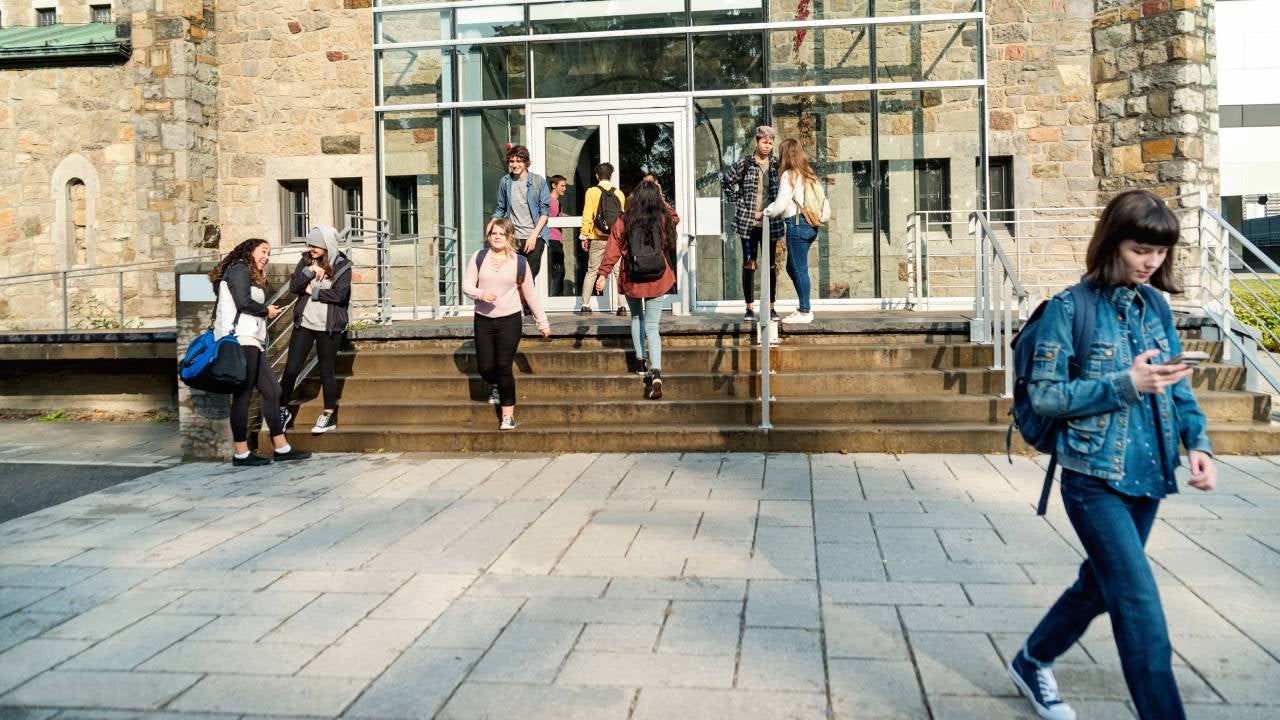First-generation college student statistics in 2022

First-generation students are those whose parents don’t have a college degree. Oftentimes, they’re also the first ones in their families to ever set foot on campus as a student. Because of this, they have little to no guidance when it comes to navigating things like college admissions, financial aid and undergraduate coursework, making it harder for them to achieve postsecondary success. However, attending college is still worth it; a college degree opens the door to more jobs and higher incomes over time.
Key first-generation college student statistics
- One-third of all college students in the U.S. are first-generation students.
- Roughly 60 percent of first-generation students were also the first sibling in their family to go to college during the 2015-16 academic year.
- The median age of first-generation college students is 23, while more than one-third of them are over the age of 30.
- Only 21 percent of Gen Z students are first-generation students.
- First-generation students are more likely to attend public two-year institutions than their peers, accounting for almost two-thirds of all students enrolled at these institutions. In 2015-16, first-generation students also made up 72 percent of the entire student body at private four-year for-profit institutions.
- Most first-generation students attend college part time.
- Sixty-six percent of first-generation students worked while in school in 2015-16, compared to 61 percent of continuing-generation students.
- It is estimated that 30 percent of first-generation students had dependents while in college in 2015-16, versus 16 percent of continuing-generation students.
- Only 27 percent of first-generation students finish college within four years.
- Business and social and behavioral sciences are some of the most popular fields of study among first-generation students.
- Fewer than half of first-generation graduates have a job that requires a bachelor’s degree one year after finishing school.
- The median household income of a first-generation college graduate is $99,600, compared to $135,800 for households of continuing-generation graduates.
What is a first-generation college student?
According to the Center for First-Generation Student Success, a first-generation student is one whose parents did not complete a four-year college or university degree — even if other members of the family have.
However, the definition may vary from one institution to the next. For instance, some colleges may consider you a continuing-generation student (aka not the first in your family to go to college) if either of your parents attended a postsecondary institution, regardless of whether they actually got their degrees.
Although these distinctions may not seem like a big deal, they are. Being a first-generation student means that you may have access to additional tools and resources to help you succeed that aren’t available to other students. That’s why it’s so important to check with your admissions office whether you fall into this category and whether you qualify for these unique opportunities.
Challenges first-generation students face
First-generation college students face a unique set of challenges, including balancing several identities, working one or multiple jobs and managing family obligations — all while trying to get an education to further their career.
But Sarah Whitley, vice president of the Center for First-Generation Student Success, says that first-generation students’ biggest hurdle for a successful college experience is their lack of understanding about how higher education works as a whole.
“Institutions can be such complex bureaucratic and jargon-filled entities it can be difficult for first-generation students to access the support and resources imperative to their success,” Whitley says. “First-generation students are often academically prepared and very talented — it’s just that sometimes they lack the information and resources needed to select the best institution for them, to understand the admissions and financial aid process, and to know the right questions to ask along the way.”
First-generation students by demographic
First-generation students come from different backgrounds, with the majority of them identifying as white, Hispanic/Latinx or Black/African American, according to the Center for First-Generation Student Success. This breakdown is similar to that of continuing-generation students. Additionally, as with continuing-generation students, the first-generation space is predominantly female, with only 40 percent of first-generation students identifying as male.
Although there isn’t much information in terms of age distribution, we do know that first-generation students tend to be older than their peers — the Postsecondary National Policy Institute found that first-generation students have a median age of 23, compared to 21 for those whose parents have at least one bachelor’s degree.
First-generation students’ household incomes
A data analysis published by the Peter G. Peterson Foundation found that households headed by high school graduates earn about 31 percent less a year than those who have an associate degree and 56 percent less than those who have a bachelor’s or another advanced degree. In other words, there’s a significant wealth gap between first-generation and continuing-generation students’ households, which could make the transition into college trickier for first-generation students.
| Educational attainment of household head | Median household income (2020) |
| Bachelor’s degree or higher | $106,936 |
| Associate degree | $68,769 |
| Some college | $60,392 |
| High school diploma | $47,405 |
| Some high school | $29,520 |
| Less than 9th grade | $29,609 |
Source: Peter G. Peterson Foundation
First-generation students’ success rates
Having parents who attended college increases the likelihood of graduating college, as students are better prepared to navigate our complex higher education system. In fact, among adults whose parents have no college experience, only 20 percent completed their degrees, versus 60 percent of those who had at least one parent with a bachelor’s degree.
First-generation student loan debt
When it comes to borrowing money to pay for college, first-generation students tend to borrow more than their peers with college-educated parents — but not by much. Pew Research Center estimates that 65 percent of first-generation students owe at least $25,000 in student loans, compared with 57 percent of continuing-generation students.
First-generation student median salary
A study by the Pew Research Center found that there’s often a wealth gap between first-generation and continuing-generation students even after they graduate. The median household income for graduates who have at least one college-educated parent was $135,800 in 2019, compared to $99,600 for graduates whose parents didn’t attend college — a a 36 percent difference.
But although first-generation graduates lack this economic advantage known as the “parent premium,” which puts them in a better position to build wealth, they do get a larger salary boost from their degrees, according to the Federal Reserve.
Tips to succeed as a first-generation college student
Although the road to college as a first-generation student may be tougher compared to that of students who have someone to guide them through the process, Whitley says that there are three things you can do for a more successful college experience.
Embrace your first-gen identity
Many first-generation students keep their status to themselves — sometimes out of fear of acceptance — which in turn holds them back from taking advantage of the unique opportunities that are available to them.
“Embracing this part of your identity can open doors to experiences and resources, so don’t keep it a secret,” Whitley says. “It is important to identify as first-generation during the admissions experience so resources and opportunities can be opened to you. There are many institutions with dedicated first-generation resources – over 275 have the Center’s First-gen Forward designation – and it is important to look for those options when shopping for colleges.”
Don’t be afraid to ask questions
One of the main hurdles that first-generation college students face is their lack of knowledge when it comes to how college works. That’s why it’s so important ask questions and reach out for help if you ever need it.
“Many campuses have support and resources available for first-generation students like TRIO. Some of these are stand-alone and others are incorporated into offers for other intersectional identities,” Whitley says. “There’s also learning and writing centers, advisors, tutors and student success initiatives to which any student can access and, most often, at no cost.”
Find a mentor within your community
One of the best things about going to college is that you’ll meet a very diverse group of people — including other first-generation students — whom you can connect with and who can guide you based on their own experiences.
Additionally, Whitley points out that many professors and other staff publicly identify as being first-generation, and they are usually happy to connect with others with similar experiences. She says that finding a faculty or staff person to serve as a resource and mentor is one of the top ways first-generation students report being more successful in college, so it’s worth giving it a shot.
You may also like

Which generation has the most student loan debt?





